Vegetable growing in winter
I know it is still early days and we may yet have blizzards and really low temperatures, but I am much encouraged with the growth of my greens (lettuce, spinach, kale, collards) and the protection provided by my row covers, so I have been growing more vegetables for transplanting in a few weeks. I googled winter hardy vegetables and bought Rapini Broccoli Raab seeds and Mache Corn Salad seeds – very reasonably priced and very quick delivery from Hirt’s Gardens. They germinated in my 3/4″ blocks quickly and are now in the greenhouse in 2″ soil blocks growing well and will be transplanted soon, together with my regulars – I really like kale and have several varieties going. Below is a snapshot of one of my raised beds – with temps>40 for next several days, I am trying one bed without covers and the other with, and will see if it makes any difference.
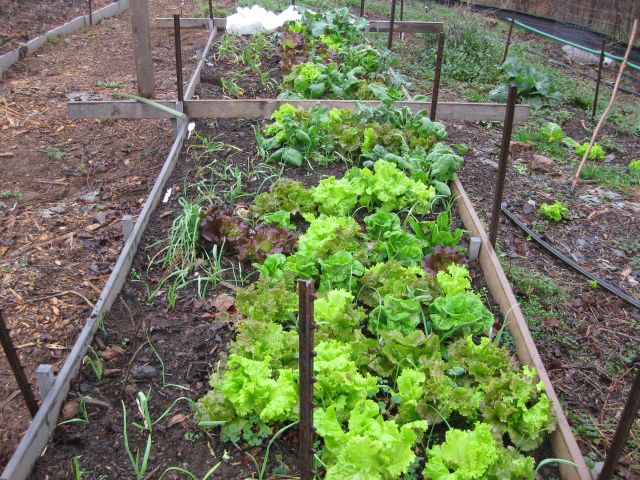
Composting
My new heap has more than 60 leaf bags. It is too much leaf and too little green. Every other day, when I clean out the coop, I toss the chickens’ contribution on the top and have also contributed some of the horse manure I picked up from the stables. I have a continuing reservation about the horse manure – don’t know what ‘cides were used to produce the hay or what chems the horses may have received – but I hope the composting process and all my soil workers will break down whatever is there that shouldn’t be. The heap is self standing and for turning it, my bobcat is invaluable. It is breaking down well, evidenced by wisps of steam and diminishing size.
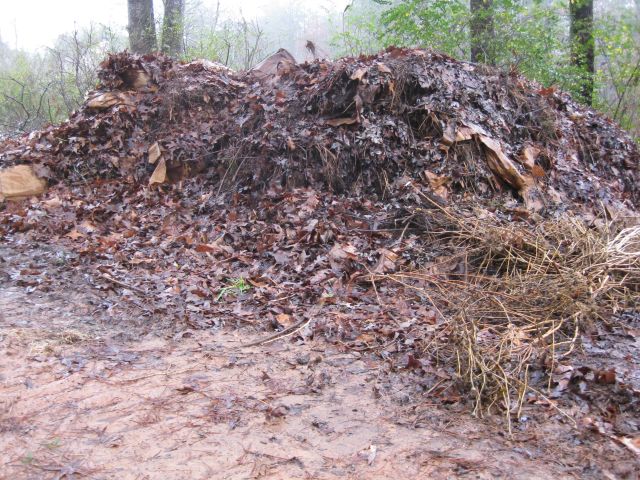
Transplanted muscadines
I completed transplanting the muscadines. I have real concerns about the outcome. Their roots had extended everywhere and I doubt that I saved even 20% of the roots. I cut back the vines by 80% and placed the roots in trenches covered with compost (compost is my universal remedy) and spring will tell how well I succeeded. To stabilize the terrace from wintry rains I seeded with winter rye and it is growing nicely as can be seen below, together with the truncated muscadines.
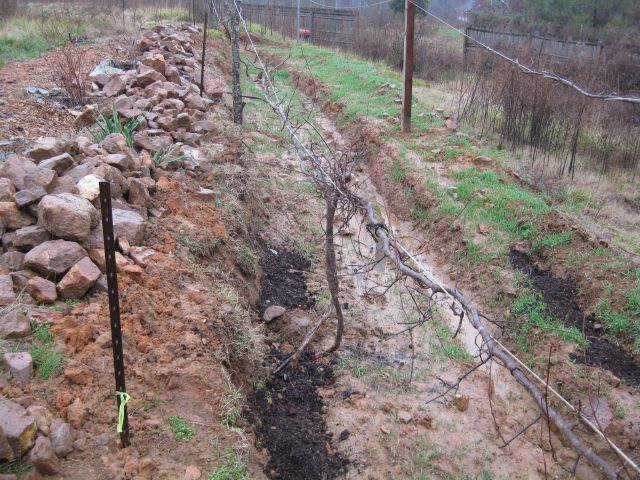
I intend to put the stones to use building stone walls – to be described in a later post.
New raised bed
With the muscadines out of the way, I decided to make a third raised bed – this is 4 ft wide and 24 ft long and is awaiting residents. As an experiment I used a few of the stones as a north border for the bed, the idea being they will act as a heat sink – absorb the heat of the winter son and create a micro climate ( I noticed that my strawberry plants which abut the south side of one of the raised bed i.e. the raised bed side is to the north of it, have produced strawberries in the middle of December!). The two 4″wide 10 ft long pipes will be positioned in the middle and above the bed for the purpose of keeping the winter cover off the vegs.
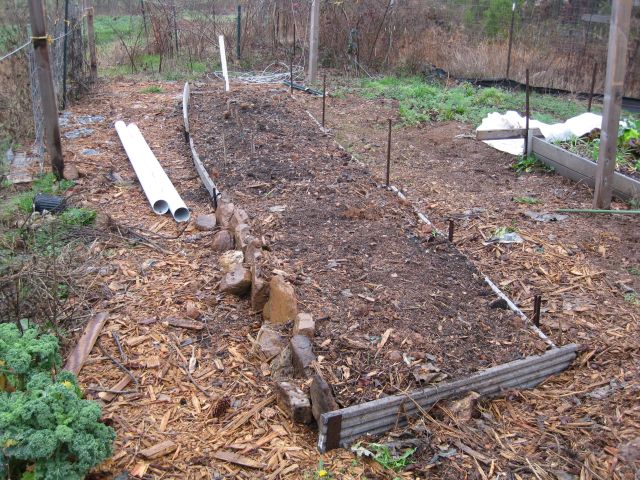
Apple tree restoration
There is a large apple tree on the hill property I recently acquired which did poorly this past year. One reason, I surmised, is that its roots tapped into a septic system which has been decommissioned and therefore it was deprived of valuable nutrients on which it had become dependent. Or it could have been the weather, or it may only bear well every other year. It is surrounded by a vigorous tough grass which competes with its roots for food. I decided to get rid of the grass. Imagine a circle with the tree in the center. I mowed all the grass in the circle. Then for 50% of the circle I spread horse manure and then wads of newspapers and then covered the lot with a generous load of wood chips. For the other half I decided on a different approach. Adjacent trees shed lots of leaves and I gathered these leaves and spread them out on the grass. Next step will be to add the wood chips. My reasoning is the leaves will block the light on which grass depends to grow, more effectively than spread newspapers. And it is quicker to spread the leaves than the paper and the leaves, being more natural than paper will probably contribute better to the health life of the soil. I am hoping the wood chips will promote growth of fungi which is better for the trees than the grass bacteria.
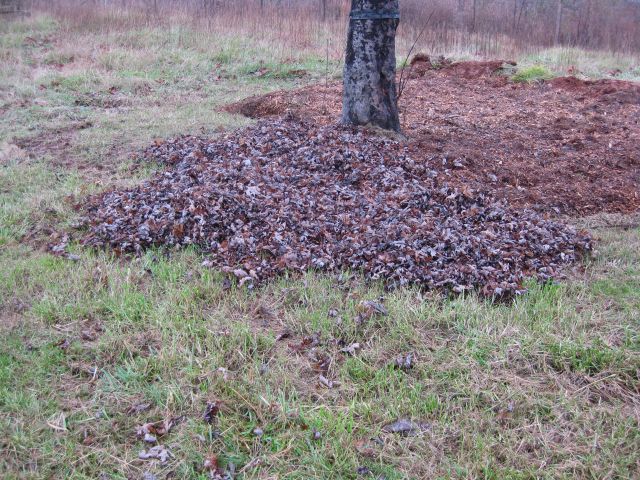
The apple tree itself does not look too impressive right now. The top half was sheared by a storm and I still have to do more pruning. Time will tell. By the way the sweet gum behind it fell victim to shearing by the local utility which has a right of way which extends to within a few feet of the trunk of the sweet gum. So the utility religiously protects its right of way with no favoritism extended. The one benefit is I received a truck load of wood chips.
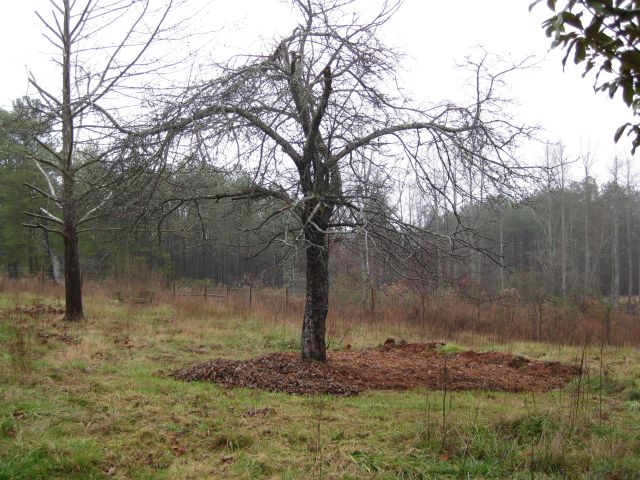
Lots of pipes
Finally a snapshot of my two gravity feed irrigation tanks. I just added the last and final pipe. Each of the pipes serves a purpose.
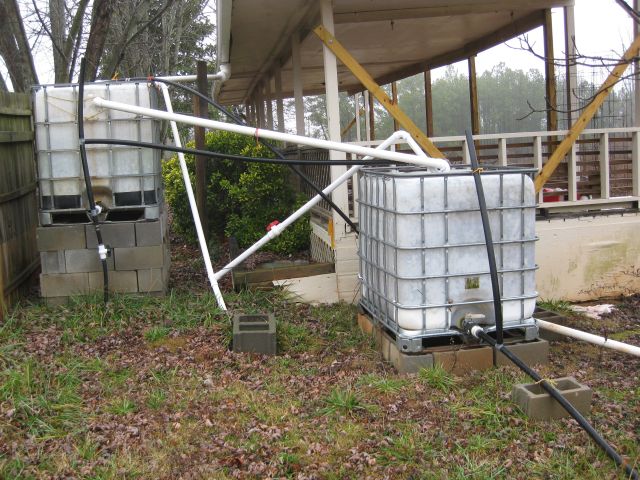
The “Y” brings the rainwater from the storage tanks. If the red valve on the lower limb is open the water goes to the right tank, if closed to the left tank. The two vertical black pipes are to facilitate bleeding out air bubbles when the valves below them are opened and water runs to the crops. The left, raised tank, irrigates hill crops, the right tank the crops at the bottom of the hill. You can spot at the top of the left tank the horizontal white pipe bringing rainwater from the roof of the deck and the diagonal black pipe bringing water from a well (only as a last resort and only pumped 3 times this past year). There are two overflow pipes from the left tank – the lower overflow is if I want the left tank to be half filled before the lower tank is filled, the upper overflow is if I want the left tank to be completely filled before the lower tank is filled. Finally, the pipe I just added is the overflow from the lower tank – you can see it is directed to the right where the fig tree resides and whichas a berm to capture as much water as possible.
